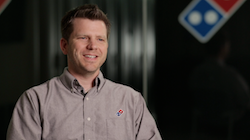 Russ Turner, Site Reliability Engineering - Manager, Domino’s Pizza
Russ Turner, Site Reliability Engineering - Manager, Domino’s PizzaSuperNova Award Category
Data to Decisions
The Company
Domino’s is a leading pizza restaurant chain founded in 1960. We have more than 10,000 corporate and franchised stores in 70 countries. In 2007, we launched our online pizza ordering service, which has since revolutionized the online delivery experience. In 2012, we had around $7.4 billion in sales.
The Problem
Our stores and online ordering service were generating mountains of machine data that took our IT and engineering teams days or weeks to analyze. We deployed Splunk Enterprise to analyze our data and increase IT efficiencies – and we were quickly able to cut costs and troubleshoot IT problems faster than before. With our enormous success and return from using Splunk, we then expanded Splunk across the company, leading to revenue insights in both business and marketing through online sales data collected across our franchise network of more than 10,000 stores.
The Solution
Using our new analytics, our IT teams were able to quickly identify and fix network bandwidth and latency, Internet connection and payment processing issues across our stores. Then we realized we could use the same kind of analysis to improve business decisions by visualizing sales trends such as orders per minute, numbers of transactions per store, types of pizza customers are ordering and the coupons they’re using to do so.
The Results
Our IT teams now resolve problems in seconds or minutes instead of hours or days. In addition, we vastly improved our insight into our business, including the effectiveness of our promotional campaigns. For example, the IT team can now track and create marketing reports about the types of devices–iPhones, Androids or Xbox’s–that are being used to place orders, or assess promotions in real time.
The Technology
We used Splunk Enterprise software, which collects, indexes and monitors machine data. Splunk software enabled us to monitor, search, analyze, visualize and act on massive streams of real-time and historical machine data.
Metrics Matter
Before, the time between identifying an issue and resolving took two to three hours. MTTR now takes less than five minutes. Overall, we saved more than $300,000 upfront by replacing our legacy technology. Our new analytics provide us answers 24–48 hours sooner than we get them from our data warehouse tools. In addition, someone in our marketing department used to be up at midnight every evening pulling data and crunching numbers. Now we can automate the entire process.
Disruptive Factor
Machine data analysis has made our IT team a bona fide source of business insight. For example, IT can compare the effectiveness of 50 percent vs. 60 percent-off coupons, so we can adjust the campaign in a day, if we need to, rather than the week it used to take. With this kind of knowledge, we can better determine where, when and how it is most lucrative to run promotional campaigns.
Shining Moment
We receive a high volume of website traffic during the Super Bowl, which is one of our biggest days in sales. During this year’s game, we used Splunk to monitor database uptime and order responses from our stores, and to track Internet outages in different parts of the country. Before we had Splunk, we would pull logs after the fact and dig through them. With Splunk, we were able to run queries and pull stats on all of the data in real time and spot errors we might have missed before. It definitely helped make the last Super Bowl our most successful ever.
 About Domino's Pizza
About Domino's Pizza
Founded in 1960, Domino's Pizza is the recognized world leader in pizza delivery, with a significant business in carryout pizza. It ranks among the world's top public restaurant brands with its global enterprise of more than 10,400 stores in over 70 international markets. Domino's had global retail sales of over $7.4 billion in 2012, comprised of over $3.5 billion in the U.S. and nearly $3.9 billion internationally. In the second quarter of 2013, Domino's had global retail sales of over $1.8 billion, comprised of $868 million in the U.S. and $961 million internationally. Its system is largely made up of franchise owner-operators who accounted for over 96% of the Domino's Pizza stores as of the second quarter of 2013. The Domino's brand generates over $2 billion in global digital sales per year. Its emphasis on new technology has helped drive the introduction of Domino's ordering apps for Kindle Fire, Android™, iPhone® and Windows Phone 8 – which now cover nearly 95% of the U.S. smartphone market. Continuing its focus on menu enhancement, Domino's established itself as a player in the pan pizza market with the launch of its Handmade Pan Pizza, featuring fresh, never-frozen dough, in October 2012.

